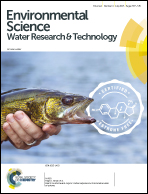Observability of anammox activity in single-stage nitritation/anammox reactors using mass balances†
Abstract
In nitritation/anammox reactors, several bacterial groups contribute to the overall nitrogen conversion. Knowing the activity of the main bacterial groups, especially of anaerobic ammonium-oxidising bacteria (AMX), is extremely helpful to understand the process and optimise its operation. Mass balances of dissolved compounds such as ammonium, nitrite and nitrate commonly allow the determination of bacterial activities in a nitritation/anammox process, but the activity of heterotrophic bacteria (HET) is usually neglected. However, even in wastewater with a low organic substrate content, heterotrophic denitrification can contribute substantially to nitrogen removal. The goal of this study was to critically evaluate the applicability of mass balances for the determination of the relevant bacterial activities in a nitritation/anammox process with high HET activity. We set up and solved mass balances of different degrees of complexity. Both linear equation systems, with catabolic reactions alone and with balances according to the activated sludge model stoichiometry, do not allow estimation of any of the considered bacterial activities. When kinetic rate expressions are included, it is possible to compute the concentrations of all considered bacterial groups, but the estimation uncertainty is far too high for practical purposes: the relative standard deviation for AMX is 5280%. In a completely autotrophic system, the relative standard deviation for AMX is only 5%, which proves that the high standard deviations are due to the complexity of the nitration–anammox process with HET activity. The high standard deviations of the calculated bacterial concentrations can be significantly reduced by adding an additional mass balance for the total biomass (standard deviation for AMX activity 1210%). The required number of measurements to achieve an acceptable precision, in our example about 600 conversion rate measurements to reach a 50% standard deviation for the AMX concentration, is still far too high though for practical purposes. To conclude, mass balances including kinetics theoretically allow the observation of the bacterial activities in nitritation/anammox reactors with high HET activity. However, the required precision of the calculated conversion rates, the uncertainty of stoichiometric and kinetic parameters and the reactor dynamics (unsteady conditions) make mass balances unsuitable for practical estimation of AMX activity. Due to high frequency and new online instruments, mass balances might become a suitable tool in the future.


 Please wait while we load your content...
Please wait while we load your content...